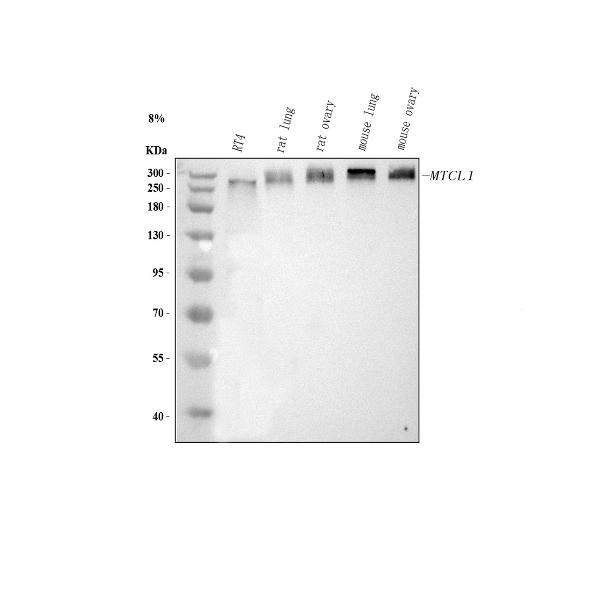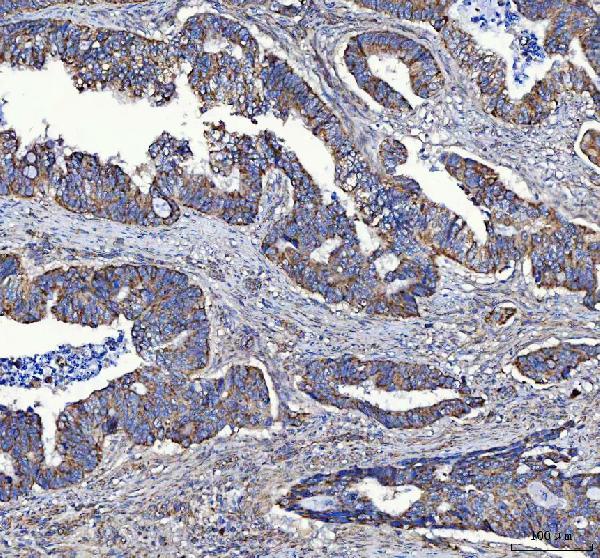Product Info Summary
| SKU: | A10954-1 |
|---|---|
| Size: | 100 µg/vial |
| Reactive Species: | Human, Mouse, Rat |
| Host: | Rabbit |
| Application: | ELISA, Flow Cytometry, IHC, WB |
Customers Who Bought This Also Bought
Product info
Product Name
Anti-MTCL1 Antibody Picoband®
SKU/Catalog Number
A10954-1
Size
100 µg/vial
Form
Lyophilized
Description
Boster Bio Anti-MTCL1 Antibody Picoband® catalog # A10954-1. Tested in ELISA, IHC, WB, Flow Cytometry applications. This antibody reacts with Human, Mouse, Rat. The brand Picoband indicates this is a premium antibody that guarantees superior quality, high affinity, and strong signals with minimal background in Western blot applications. Only our best-performing antibodies are designated as Picoband, ensuring unmatched performance.
Storage & Handling
At -20°C for one year from date of receipt. After reconstitution, at 4°C for one month. It can also be aliquotted and stored frozen at -20°C for six months. Avoid repeated freezing and thawing.
Cite This Product
Anti-MTCL1 Antibody Picoband® (Boster Biological Technology, Pleasanton CA, USA, Catalog # A10954-1)
Host
Rabbit
Contents
Each vial contains 4 mg Trehalose, 0.9 mg NaCl, 0.2 mg Na2HPO4.
Clonality
Polyclonal
Isotype
Rabbit IgG
Immunogen
E.coli-derived human MTCL1 recombinant protein (Position: K884-D1522).
*Blocking peptide can be purchased. Costs vary based on immunogen length. Contact us for pricing.
Cross-reactivity
No cross-reactivity with other proteins.
Reactive Species
A10954-1 is reactive to MTCL1 in Human, Mouse, Rat
Reconstitution
Adding 0.2 ml of distilled water will yield a concentration of 500 µg/ml.
Observed Molecular Weight
270-300 kDa
Calculated molecular weight
209.526kDa
Background of MTCL1
MTCL1 (microtubule cross-linking factor 1), also known as CCDC165 (Coiledcoil domain-containing protein 165), SOGA2 or MTCL1, is a 1,905 amino acid protein that localizes to the cell membrane, cytoplasm and cytoskeleton. MTCL1 is a microtubule-associated factor that plays a role in regulating polarization and microtubule dynamics as well as the development and maintenance of non-centrosomal microtubule bundles. MTCL1 is encoded by a gene that maps to chromosome 18 and is expressed as four isoforms due to alternative splicing events. Chromosome 18 encodes over 300 genes and contains about 76 million bases. Trisomy 18, or Edwards syndrome, is the second most common trisomy after Downs syndrome. Symptoms of Edwards syndrome include low birth weight, a variety of physical development defects, heart deformations and breathing difficulty. Translocation between chromosome 18 and 14 is the most common translocation in cancers, and occurs in follicular lymphomas. Niemann-Pick disease, hereditary hemorrhagic telangiectasia and erythropoietic protoporphyria are associated with chromosome 18. The TGFβ modulators, Smad2, Smad4 and Smad7 are encoded by chromosome 18.
Antibody Validation
Boster validates all antibodies on WB, IHC, ICC, Immunofluorescence, and ELISA with known positive control and negative samples to ensure specificity and high affinity, including thorough antibody incubations.
Application & Images
Applications
A10954-1 is guaranteed for ELISA, Flow Cytometry, IHC, WB Boster Guarantee
Assay Dilutions Recommendation
The recommendations below provide a starting point for assay optimization. The actual working concentration varies and should be decided by the user.
Western blot, 0.25-0.5 μg/ml, Human, Mouse, Rat
Immunohistochemistry, 2-5 μg/ml, Human, Mouse, Rat
Flow Cytometry (Fixed), 1-3 μg/1x106 cells, Human
ELISA, 0.1-0.5 μg/ml, -
Positive Control
WB: human RT4 whole cell, rat lung tissue, rat ovary tissue, mouse lung tissue, mouse ovary tissue
IHC: human colorectal adenocarcinoma tissue, mouse cerebellum tissue, rat cerebellum tissue
FCM: U20S cell
Validation Images & Assay Conditions

Click image to see more details
Figure 1. Western blot analysis of MTCL1 using anti-MTCL1 antibody (A10954-1).
Electrophoresis was performed on a 5-20% SDS-PAGE gel at 70V (Stacking gel) / 90V (Resolving gel) for 2-3 hours. The sample well of each lane was loaded with 30 ug of sample under reducing conditions.
Lane 1: human RT4 whole cell lysates,
Lane 2: rat lung tissue lysates,
Lane 3: rat ovary tissue lysates,
Lane 4: mouse lung tissue lysates,
Lane 5: mouse ovary tissue lysates.
After electrophoresis, proteins were transferred to a nitrocellulose membrane at 150 mA for 50-90 minutes. Blocked the membrane with 5% non-fat milk/TBS for 1.5 hour at RT. The membrane was incubated with rabbit anti-MTCL1 antigen affinity purified polyclonal antibody (Catalog # A10954-1) at 0.5 μg/mL overnight at 4°C, then washed with TBS-0.1%Tween 3 times with 5 minutes each and probed with a goat anti-rabbit IgG-HRP secondary antibody at a dilution of 1:5000 for 1.5 hour at RT. The signal is developed using an Enhanced Chemiluminescent detection (ECL) kit (Catalog # EK1002) with Tanon 5200 system. A specific band was detected for MTCL1 at approximately 270-300 kDa. The expected band size for MTCL1 is at 210 kDa.

Click image to see more details
Figure 2. IHC analysis of MTCL1 using anti-MTCL1 antibody (A10954-1).
MTCL1 was detected in a paraffin-embedded section of human colorectal adenocarcinoma tissue. Heat mediated antigen retrieval was performed in EDTA buffer (pH 8.0, epitope retrieval solution). The tissue section was blocked with 10% goat serum. The tissue section was then incubated with 2 μg/ml rabbit anti-MTCL1 Antibody (A10954-1) overnight at 4°C. Peroxidase Conjugated Goat Anti-rabbit IgG was used as secondary antibody and incubated for 30 minutes at 37°C. The tissue section was developed using HRP Conjugated Rabbit IgG Super Vision Assay Kit (Catalog # SV0002) with DAB as the chromogen.

Click image to see more details
Figure 3. IHC analysis of MTCL1 using anti-MTCL1 antibody (A10954-1).
MTCL1 was detected in a paraffin-embedded section of mouse cerebellum tissue. Heat mediated antigen retrieval was performed in EDTA buffer (pH 8.0, epitope retrieval solution). The tissue section was blocked with 10% goat serum. The tissue section was then incubated with 2 μg/ml rabbit anti-MTCL1 Antibody (A10954-1) overnight at 4°C. Peroxidase Conjugated Goat Anti-rabbit IgG was used as secondary antibody and incubated for 30 minutes at 37°C. The tissue section was developed using HRP Conjugated Rabbit IgG Super Vision Assay Kit (Catalog # SV0002) with DAB as the chromogen.

Click image to see more details
Figure 4. IHC analysis of MTCL1 using anti-MTCL1 antibody (A10954-1).
MTCL1 was detected in a paraffin-embedded section of rat cerebellum tissue. Heat mediated antigen retrieval was performed in EDTA buffer (pH 8.0, epitope retrieval solution). The tissue section was blocked with 10% goat serum. The tissue section was then incubated with 2 μg/ml rabbit anti-MTCL1 Antibody (A10954-1) overnight at 4°C. Peroxidase Conjugated Goat Anti-rabbit IgG was used as secondary antibody and incubated for 30 minutes at 37°C. The tissue section was developed using HRP Conjugated Rabbit IgG Super Vision Assay Kit (Catalog # SV0002) with DAB as the chromogen.

Click image to see more details
Figure 5. Flow Cytometry analysis of U20S cells using anti-MTCL1 antibody (A10954-1).
Overlay histogram showing U20S cells stained with A10954-1 (Blue line). To facilitate intracellular staining, cells were fixed with 4% paraformaldehyde and permeabilized with permeabilization buffer. The cells were blocked with 10% normal goat serum. And then incubated with rabbit anti-MTCL1 Antibody (A10954-1, 1 μg/1x106 cells) for 30 min at 20°C. DyLight®488 conjugated goat anti-rabbit IgG (BA1127, 5-10 μg/1x106 cells) was used as secondary antibody for 30 minutes at 20°C. Isotype control antibody (Green line) was rabbit IgG (1 μg/1x106) used under the same conditions. Unlabelled sample (Red line) was also used as a control.
Protein Target Info & Infographic
Gene/Protein Information For MTCL1 (Source: Uniprot.org, NCBI)
Gene Name
MTCL1
Full Name
Microtubule cross-linking factor 1
Weight
209.526kDa
Superfamily
SOGA family
Alternative Names
Interleukin-17B; IL-17B; Cytokine CX1; Cytokine-like protein ZCYTO7; Neuronal interleukin-17-related factor; Il17b; Nirf, Zcyto7 MTCL1 CCDC165, KIAA0802, SOGA2 microtubule crosslinking factor 1 microtubule cross-linking factor 1|PAR-1-interacting protein|SOGA family member 2|coiled-coil domain containing 165|coiled-coil domain-containing protein 165
*If product is indicated to react with multiple species, protein info is based on the gene entry specified above in "Species".For more info on MTCL1, check out the MTCL1 Infographic

We have 30,000+ of these available, one for each gene! Check them out.
In this infographic, you will see the following information for MTCL1: database IDs, superfamily, protein function, synonyms, molecular weight, chromosomal locations, tissues of expression, subcellular locations, post-translational modifications, and related diseases, research areas & pathways. If you want to see more information included, or would like to contribute to it and be acknowledged, please contact [email protected].
Specific Publications For Anti-MTCL1 Antibody Picoband® (A10954-1)
Hello CJ!
No publications found for A10954-1
*Do you have publications using this product? Share with us and receive a reward. Ask us for more details.
Recommended Resources
Here are featured tools and databases that you might find useful.
- Boster's Pathways Library
- Protein Databases
- Bioscience Research Protocol Resources
- Data Processing & Analysis Software
- Photo Editing Software
- Scientific Literature Resources
- Research Paper Management Tools
- Molecular Biology Software
- Primer Design Tools
- Bioinformatics Tools
- Phylogenetic Tree Analysis
Customer Reviews
Have you used Anti-MTCL1 Antibody Picoband®?
Submit a review and receive an Amazon gift card.
- $30 for a review with an image
0 Reviews For Anti-MTCL1 Antibody Picoband®
Customer Q&As
Have a question?
Find answers in Q&As, reviews.
Can't find your answer?
Submit your question





